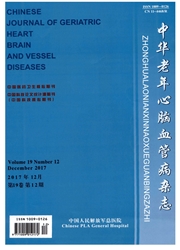

 中文摘要:
中文摘要:
目的探讨外源性成纤维生长因子21(fibroblast growth factor,FGF21)对载脂蛋白E基因敲除(apoE-/-)小鼠血脂和动脉粥样硬化形成的影响及可能机制。方法雄性apoE-/-小鼠24只,随机分为2组:模型组12只和FGF21组12只,另外12只雄性C57BL/6J小鼠作为对照组。3组均给予高脂饮食8周诱导动脉粥样硬化斑块形成。采血测定血脂,通过HE和油红O染色观察斑块的形态,基因和蛋白表达分别应用实时荧光PCR和Western blot进行检测。结果模型组血管内膜增厚,内膜及中膜均可见巨噬细胞、细胞外脂质沉积及脂质侵蚀。与模型组比较,FGF21组TG[(1.82±0.37)mmol/L vs(2.56±0.39)mmol/L]、TC[(6.27±0.62)mmol/L vs(9.27±0.85)mmol/L]、LDL-C[(2.73±0.26)mmol/L vs(4.37±0.77)mmol/L]明显降低,HDL-C[(1.49±0.25)mmol/L vs(0.99±0.23)mmol/L]、过氧化物酶体增殖物激活受体γmRNA[(4.753±0.648)vs(1.348±0.158)]和FGF受体1mRNA[(145.064±33.203)vs(8.505±11.196)]明显升高(P〈0.01)。结论FGF21能降低apoE-/-小鼠血脂及斑块形成,机制可能是通过增加过氧化物酶体增殖物活化受体γ的表达。
 英文摘要:
英文摘要:
Objective To study the effect of exogenous FGF21 on lipid metabolism and atherosclerosis in apoE knockout mice and its mechanism.Methods Twenty-four male apoE knockout mice were randomly divided into model group and FGF21 treatment group(12in each group).Another12 male C57BL/6Jmice served as a control group.Carotid atherosclerosis was induced in the animals with a high fat diet for 8weeks.Blood samples were taken to test blood lipid.Morphology ofatherosclerotic plaques was observed with HE and oil Red O staining.Gene and protein expressions were detected by RT-PCR and Western blot.Results Typical atherosclerosis was observed in model group,which was characterized by unsmooth aortic intima,fibrosis plaques and infiltration of massive inflammatory cells.The serum levels of TG [(1.82±0.37)mmol/L vs(2.56±0.39)mmol/L],TC[(6.27±0.62)mmol/L vs(9.27±0.85)mmol/L],LDL-C [(2.73±0.26)mmol/L vs(4.37±0.77)mmol/L]were significantly lower whereas those of HDL-C [(1.49±0.25)mmol/L vs(0.99±0.23)mmol/L],PPARγmRNA [(4.753±0.648)vs(1.348±0.158)]and FGFR1mRNA[(145.064±33.203)vs(8.505±11.196)]were significantly higher in FGF21 treatment group than in model group(P〈0.01).Conclusion FGF21 reduces lipid metabolism and plaque formation in apoE knockout mice by upregulating the expression of PPARγ.
 同期刊论文项目
同期刊论文项目
 同项目期刊论文
同项目期刊论文
 Fibroblast growth factor 21 as a possible endogenous factor inhibits apoptosis in cardiac endothelia
Fibroblast growth factor 21 as a possible endogenous factor inhibits apoptosis in cardiac endothelia 期刊信息
期刊信息
